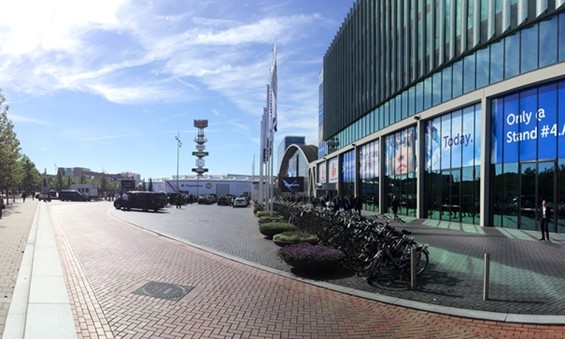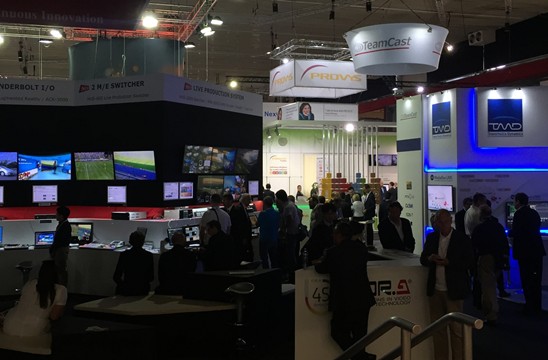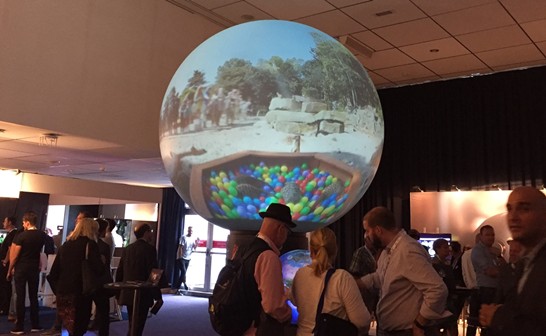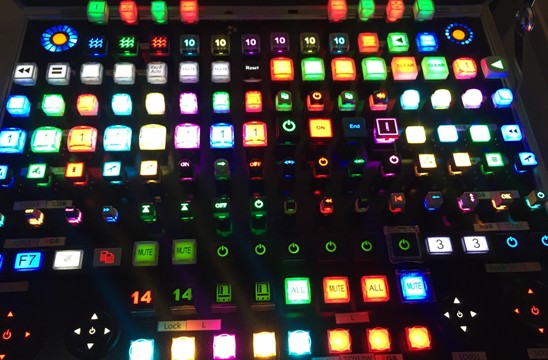Last weekend, the annual International Broadcasting Convention (IBC) Conference was held in Amsterdam. This is a chance for technology companies from across the world to showcase their most ground-breaking technologies for sound and screen. The IBC Big Screen gives delegates the chance to get a glimpse of new directions for cinema projection, new kit and how the industry at large is responding to changes in the way we want to view and access content. Eight of our Technical Ambassadors attended and I spoke to some of them to get their feedback on what excited them most and what they think will affect the future for our independent screens.
Jenni Graham, Queen’s Film Theatre, Belfast
1) What did you see at IBC that made you think wow!?
The little cameras from Telstra. These were full 1080 remote wearable cameras which are going to give people a completely new perspective on sports, and indeed are at the minute, you see it in rugby and in baseball (the only sports I watch so I am sure there are more!). I just couldn’t get over how small and light they were,it literally fit in the palm of my hand and my phone is probably heavier. They 3D print them for each event so they fit perfectly in whatever they’re attached to, be it an umpire’s mask, a body harness or a bike handle, and the picture quality from them is incomparable. I just thought they were fan dangled.
2) What do you think is the future of the technical side of independent cinema?
I think we’re going to have a lot of catching up to do. Independents are going to be nowhere near the front of the queue for taking up these Premium Large Format screen offerings, as a fair amount of the content we show just won’t need them. But in five years if they won’t be making xenon projectors any more, we’ll have to convert to laser.Hopefully by then the cost will have come down enough that we can afford to upgrade our projectors because the content will be being produced to a higher standard than we’ll be able to show, and people will notice the difference.
The equipment to make films now is already beyond what we can show, e.g. cameras are going to be HDR and televisions will have the potential to show a better picture than cinemas. 4K HDR TVs will be allover the market at Christmas and 65″ is becoming the norm with 32″ TVs now considered small. How can independent cinemas keep up?People expect high quality and content on demand and that was pretty evident from IBC; people want to view content everywhere, instantly and in high quality. But that is not cinema. With content being released day on date and people having these super television sets, why should they come to the cinema?
A lot of this stuff is gimmicky at the moment,and yes people will travel to see something presented in Atmos with laser projection in High Frame Rate and High Dynamic Range, but not for every film. Eventually that will be the norm and independent cinema will have to keep up.There won’t be the same nostalgia for xenon 2K digital as there is for 35mm; people won’t be forgiving of a lesser picture quality once these things are established. In the meantime, independent cinemas are going to have to work out how best to improve: whether we jump on the bandwagon and go full gimmick or whether we end up with ‘just’a new projector. Most of it will probably come down to cost, but when you have a projectionist running your theatre, you have someone who cares about what they’re putting out there and they will want the best. For now, we have a lot of new phrases to learn.
I mention projection, but of course content delivery is changing; there are an every increasing number of ‘boxes’ in a booth now that just do stuff, and whilst this may decrease, more boxes are going to be needed to cope with what is coming, and that means that technical teams are going to have a lot of learning to do. Also, the profusion of new ideas means there are many new ways we can do things, many new options for our educational programmes for example. We don’t need to bring pupils to the cinema, we can bring the cinema to them, streaming talks and discussions to them and screening films on portable equipment. We can have more events that aren’t actually limited by physic allocation. Q&As can be sent via satellite to multiple destinations, but that is mightily expensive. How about we broadcast it on a streaming service instead? The tech is getting better to allow these things without the headaches and nerves that come with them failing. We are still limited by conventional thinking when we should embrace the possibilities open to us, collaborating to distinguish us from the multiplexes. They may have the shiny new things sooner than us, but our aim is to engage with our audience, not to have people check out when they come to us – and there are plenty of shiny new ways to do that as well.
3) Whats one thing that anyone can do that makes a big difference to the experience of watching a film?
Care. Care about your presentation and do the little things that will make it better.
We have to compete with content everywhere on every improving television screen; even on people’s tablets and phones. So make sure our picture quality is the best it can be, make sure your sound is properly aligned and your atmosphere is just right. Make people want to put down their devices and experience the film, whether it’s to escape for a while or to learn. Cinema is magical, make it feel that way.
Symon Culpan, National Media Museum, Bradford
1) What did you see at IBC that made you think wow!?
Quite a lot. I’ve never laid eyes on a 50ft Technocrane before and it certainly lived up to expectation! I also fell in love with the new Steenbeck that allows you to digitise as you go. However,limiting my response ONLY to the field of cinema exhibition, the biggest”Wow!” was High Dynamic Range (HDR). The Revenant looked extremely good but it was the black test before the screening that really impressed me. It’s also a genuine improvement in imaging standards and not just a marketing gimmick or a fad; it will genuinely make the images on the screen better. However, I remain somewhat sceptical about the panel debate around return on investment on High Dynamic Range. I think the guy from Barco was right when he said people are willing to pay a premium for things they can immediately see a benefit in. I’ve heard audiences feed back that they would welcome more comfortable seating, more leg room,better wine etc, but I’ve never heard of anyone demanding better black levels (or a laser light source for that matter). It just isn’t something your average cinema-goer is aware of, and as such I doubt they would willingly part with 2 extra for it.
2) What do you think is the future of the technical side of independent cinema?
In the short term I don’t anticipate much change.Traditionally the independents are less concerned with ‘bells and whistles’ (partly because their audience demographic isn’t) and are traditionally late adopters. It’s important to consider how much of the agenda at IBC is set by big industry players who are more interested in the bottom line and reaching the 18-25 demographic. Most of the exhibitors I’ve met on the scheme are more concerned about showing quality product at an affordable price than they are about exhibition standards. That said, I do think that if the larger chains and ‘plexes are updating and retrofitting then it could well mean some really good, fairly new, second hand equipment up for grabs if exhibitors play their cards right. When the industry switched to digital, the larger companies traditionally just junked their 35mm equipment en masse as opposed to selling it on, but I think they’re less likely to do the same with outgoing digital kit as it’s much more valuable, and the executives who recently shelled out for the original digital equipment will want to see some return on their investment, so selling off their old kit will offset the cost of the new.
Also I think in the independent exhibition sector there is some definite advantage to sitting on the fence a while. Right now we’re being sold various technological developments (HFR, HDR, 3D, Atmos, Escape, Auro, Laser projection) as the next big thing, but if the history of our industry tells us anything, it’s that most competing formats will eventually cede to a clear winner. For example, it echoes the widescreen race in the ’50s-’60s when a slew of high profile novelty formats came on the market as a means to lure audiences back into the cinema after the advent of television. Ten years later, most were already on their way to becoming technological curios (only Cinemascope and 6 channel surround sound cemented any real place as industry standards). History also suggests that any period of rapid technological development within our industry will plateau. Exhibitors tire of constant upgrades and retrofits and forever being sold the “next big thing”, and even some new technologies that really could transform the industry will fail to do so. Throughout 100 years of the cinema industry, almost every decade of strong technological advancement has been followed by two decades of little change.
More worryingly, I suspect that if the proposed advancements in “premium” experiences in the ‘plexes really does take off, independent film could be pushed out of the cinema exhibition sector even more than it has been already. If a tent pole release has 120 fps 2D/3D versions, normal 24 fps versions, premium large format versions, HDR versions, boutique cinema screenings and cheaper “normal” screenings (in any combination of the above), then the only logical result is that the title will open on more screens, at more sites, at different price bands. If tent poles are dominating the ‘plexes more and more then smaller releases are pushed further toward online and VoD platforms (the internet is already becoming the best place to discover interesting and alternative forms of cinema). If tent poles are to be made in 120 fps 3D then the cost of making them will increase, causing ever risk averse studios to take even fewer risks and the disparity of budget between independent and studio productions only likely to increase. That said (and to end on a more upbeat note), we might all start to tire of the fifth-or-sixth Avatar sequel in 120 fps 3D IMAX and find appetites for low-budget 2D honest-to-goodness storytelling increase again! After all, the era of big, colourful MGM musicals and Hollywood excesses of the ’50s and ’60s eventually gave way to the new wave of American independents (with Hello Dolly released the same year as Easy Rider – hard to believe but it’s true!). So there is still hope.
3) Whats one thing that anyone can do that makes a big difference to the experience of watching a film?
As an audience member: turn your phone off, keep your mouth shut and don’t eat noisy food. Or in other words, be respectful of the fact that cinema is a shared experience and just because you paid 10 for your ticket it doesn’t give you the right to spoil the experience for others around you; they paid 10 too. I’ll sound like an old curmudgeon (I’m 32!) but I never cease to be amazed by the selfish and rude behaviour of cinema-goers and it seems to be getting worse.
As an exhibitor: have a standard, be proud of who you are and passionate about what you’re doing. Measure yourself against that standard. Be aware of the occasions when you fail to meet it and strive to do better. Never settle for second best just because your audience isn’t complaining. You can make all manner of excuses but you know when you’re not giving enough. If you don’t, call the ICO and book a visit from a TA!
Simon Nichols, Borderlines Film Festival
1) What did you see at IBC that made you think wow!?
Ang Lee’s demo was incredible double WOW but also the 3D Jungle Book with laser projection had an additional WOW factor. I’m not a big fan of 3D but with the correct brightness levels I can see how this is more engaging.
2) What do you think is the future of the technical side of independent cinema?
Hopefully once technology costs reduce it should be very promising for the future. If I was running an independent cinema now I would be keen to explore the potential to re-launch 3D with laser technology.Otherwise, I’m not sure I’d want to invest in anything additional at present, as screen size is quite small and the quality with current equipment is pretty good.
3) Whats one thing that anyone can do that makes a big difference to the experience of watching a film?
For me the one thing that makes a difference is(and always has been) showmanship. Lighting, music, the opportunity to watch credits without being cleaned up around…! Etc).
Robbie Duncan, Glasgow Film Theatre
1) What did you see at IBC that made you think wow!?
Obviously the Ang Lee thing, but that was less’wow!’ and more AARRRRGGHHHH oh actually that’s quite interesting. Beyond that, I’d have to say that both NHK’s 8K OLED technology and some of the ultrafine pitch LED screen’s were full of ‘wow!’. The roll away OLED screen was incredibly impressive and has the potential to really change small film screenings by doing away with the projector completely. Never in the cinema environment itself, but in terms of events it’s a really interesting step.
2) What do you think is the future of the technical side of independent cinema?
How long do you have? Mostly I think it’s about staying relevant and investing in the right technology that keeps the cinema’s on par with the PLF screens but with a more interesting catalogue of programming. Many will continue to attend events at independent cinema’s purely because of the content, fully aware that they don’t have the budgets to compete, but it would be a mistake to lay down or think about investing much later into current trends of High Brightness and HDR. Kind of related to the first question, I went to the EYE Film Museum and Path Tuchinsky and asked to see the booths, I was extremely impressed with the Netherlands ability to have independent cinemas that still had access to extremely high quality equipment,I think Amsterdam was a real proof of concept (as is Scandanavia) that it’s possible.
3) Whats one thing that anyone can do that makes a big difference to the experience of watching a film?
Showmanship. It’s not sitting down and watching a film the way you do in the house, always try and inject a bit of theatre to the event and try to make the screen a magic experience again.
Leigh Heathcote, Broadway, Nottingham
1) Whatdid you see at IBC that made you think wow!?
A few things for me, easily the extended look at The Martian in 4K/HDR via the Dolby Vision projector was simply the best thing I have ever seen projected. Certainly for an image the size of a large format screen. It looked absolutely stunning. A “wow” moment simply from a technical point of view.
One of the other things being discussed, while not currently a reality and perhaps a good few years off was the concept of’Laser Farms’. The idea that a multiplex could use a singular large laser light source to then feed all of the projectors on a particular site is remarkable, and ‘Laser Farming’ is quite possibly the most inherently futuristic idea I’ve come across in a while.
Not really discussed at any of the keynotes was LED panel technology but the SONY CLEDIS 4K Crystal LED display on the show-floor was really impressive. The practicability and affordability of technology like this in the cinema rather than the advertising sector is something I’d like to hear more about.It could have an amazing impact for outdoor and premium small format cinema, I guess pricing/set-up might affect the chances of that happening.
2) What do you think is the future of the technical side of independent cinema?
Laser technology as a light source for projection is very much on the horizon and looks like the future for indie and mainstream cinema.Although it will co-exist with xenon for a long time, once the market is split and perhaps more competitive it might provide an opportunity for smaller cinemas to upgrade series one digital machines at a more affordable price.Laser phosphor technology must be appealing to independent cinemas looking to upgrade in the next 2-3 years.
The idea of a Central Distribution Network (CDN) could allow independent programmers to take advantage of the new distribution technology available to them, allowing them to almost crowd source screenings from an extensive library of archive/indie titles with a direct connection to distributors to deliver content and KDM’s, and offering almost instant bookings on audience demand. Although this could be a tech solution for an idea that doesn’t have universal support, I thought the idea of a group of people getting together on an evening to then “vote” for what they wanted to see at the cinema is pretty neat.
3) Whats one thing that anyone can do that makes a big difference to the experience of watching a film?
Attention to detail, good lens set-up, a nicely framed image. Close attention to audio levels and good calibration of audio equipment is key. And I think as demonstrated during the the Dolby Vision show-reel, the less light the better! A darker auditorium is great for contrast levels and can really make an image pop, the lowest light levels you can allow will provide you with the best results from your equipment whatever it is.
Ian Brown, Film Mobile, Scotland
1) What did you see at IBC that made you think wow!?
For me it was the 35mm print scanners and content delivery systems. If independent cinemas are going to move forward, we need to make use of new technologies to show more archive and rare film, and also need to be push harder for better means of content delivery to remote and rural locations.
2) What do you think is the future of the technical side of independent cinema?
Digital projection has opened up much more content for cinemas(e.g. alternative content/event cinema) and has allowed them to offer a more varied programme. But this can be pushed further still with independent cinemas streaming or showing live Q&As from major film festivals, or other events giving added value to customers no matter where they are in the country. The technology is there, we just need to work with festivals and larger cinemas to support the smaller ones.
3) Whats one thing that anyone can do that makes a big difference to the experience of watching a film?
For me it’s all about the details. Take time and get the support you need to offer the best calibrated sound, perfect picture and use the best format you have access to. If you can do that, the right film will make the audience forget where they are and be transported into the film itself. It doesn’t need to be HFR, 3D, 4K or luxury seating; it just needs to be the right programme for your audience and the most professional presentation within your budget. The support that the ICO offer via its Technical Ambassador scheme I feel is an invaluable tool for community cinemas.





